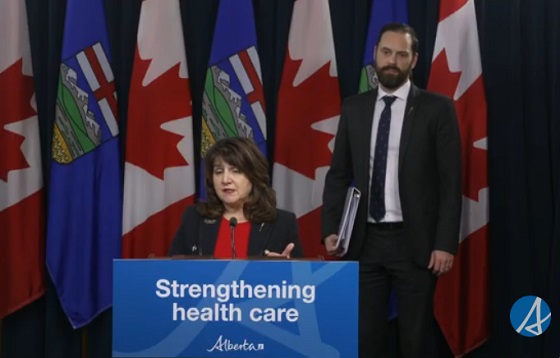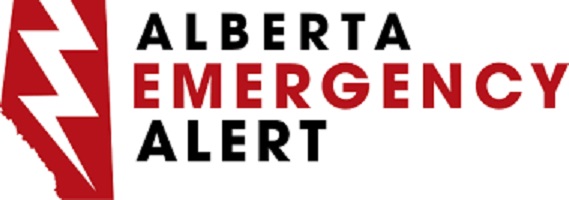Alberta
COVID-19 Friday update, 4 new deaths, 58 new case, outdoor gatherings upped to 50 people, Dr. Hinshaw cutbacks & more

In the government’s COVID-19 Friday May 15th update, chief medical officer of health for Alberta Dr. Deena Hinshaw reported four more deaths, 58 new case, changes to the outdoor gathering rules now up to 50 people and she plans to cutback her attendance at the daily reports, among other information.
There have been four new deaths and 58 new case since Thursday’s report. Alberta has now had a total of 125 deaths and 6,515 confirmed cases of the coronavirus since the pandemic began here in early March. The four latest victims were residents of continuing care facilities in the Calgary Zone. There are currently 1,073 active cases across the province, 62 of them in hospital, and nine of those in intensive care units.
Dr. Hinshaw had a message for Albertans as they head into a long weekend, “Even while we begin to enter Stage 1 of our relaunch, let us remember this virus still poses a risk, particularly to the elderly and people with chronic medical conditions,” Adding, “We need to remember that no Albertan is expendable.”
“The better that we can collectively hold our infection rate stable and low as we move into this Stage 1, the quicker we can move into Stage 2,” Dr. Deena Hinshaw

The Canadian Forces Snowbirds over City of Edmonton as part of cross country tour to thank essential workers, Hugo Sanchez Photography
Updated guidelines for outdoor gatherings to 50 people
“As we start to ease certain restrictions, it is increasingly important that we all continue to take proper precautions to prevent the spread of COVID-19.” Hinshaw said As the weather continues to warm up and just in time for the long weekend, the limit for outdoor gatherings has increased from 15 to 50 effective Friday May 15.
- Albertans are still asked to keep a two-metre distance from others and practising proper hygiene.
- If you’re holding a gathering in your backyard, you’re encouraged to sanitize doorknobs and washrooms if guests are going inside and have hand sanitizer available. Indoor gatherings are still limited to a maximum of 15 people or fewer.
- Physical distance of two metres must remain between people from different households, and attendees must follow proper hygiene practices.
- Attendees should not share food or drinks.
- Indoor gatherings are still limited to fewer than 15 people, except when otherwise identified in public health orders such as workplaces, places of worship, and in restaurants.
- Download the ABTraceTogether app and turning it on when leaving home.
Staying safe over the long weekend
Provincial parks are open, but some facilities remain closed, campfires are not permitted, and camping does not open until June 1.
Albertans should follow public health guidelines and take extra steps to keep members of their household safe when heading to provincial parks, cottages, and onto public land this weekend.
This includes:
- Respecting the health and safety of small communities along the way by planning their trip without stops for gas or food, where possible. Continuing to practise physical distancing and proper handwashing.
- Respecting municipal restrictions for playgrounds. If playgrounds can be accessed, encourage children to play with children in the same household or their cohort family, sanitize hands before or after playing on a play structure, and remember to wash everyone’s hands thoroughly as soon as possible.
- Download the ABTraceTogether app and turning it on when leaving home.

Alberta’s chief medical officer of health Dr. Deena Hinshaw provided update on Friday, May 15th. (Chris Schwarz/Government of Alberta)
Dr. Hinshaw to reduce her attendance at media updates
In a surprise announcement, the stoic, confident, strong face and voice Albertans have grown accustomed at the daily Covid-19 update, Dr. Hinshaw announced she is cutting back her attendance after this long weekend.
Explaining, “The pandemic is far from over,” Hinshaw said. “However, in consideration of the reduced number of cases overall and the fact that we have begun to resume operations under Stage 1 of Alberta’s relaunch strategy, I made the recommendation to scale down the frequency of my availabilities.”
“I know many have become accustomed to these daily updates. I ensure you I remain committed to transparency and while the number of availabilities may decrease, I will continue to provide the information you rely on.” She said
Hinshaw new schedule for attending news conferences will be every other weekday, starting Tuesday, but of course would revert back if Covid-19 numbers or policies changed significantly. Updates on numbers will be provided daily in online reports throughout the long weekend.
Coviod-19 by the numbers. Alberta cases as of Friday:
- 58 new cases reported, bringing the number of total active cases to 1,073.
- There are 103 active cases and 576 recovered cases at continuing care facilities; 91 residents at these facilities have died.
- The total deaths are 125. With 89 in the Calgary zone, 15 in the North zone, 12 in the Edmonton zone, eight in the South zone and one in the Central zone.
- Calgary zone: 870 active, 3,505
- South zone: 106 active, 1,069
- Edmonton zone: 61 active, 444 recovered.
- North zone: 18 active, 195
- Central zone: 13 active, 85 recovered.
- Five active cases and 19 recovered cases in zones yet to be confirmed
- There have been 189,225 people tested for COVID-19, with a total of 204,723 tests performed by the lab. In the last 24 hours, 4,505 tests have been completed.

Interactive aggregate data on COVID-19 cases in Alberta
https://www.alberta.ca/stats/covid-19-alberta-statistics.htm
Daily updates from Alberta Government https://www.alberta.ca/news.aspx
Alberta Connects hours of operation
- The Alberta Connects Contact Centre (310-4455) has resumed normal operating hours and is available to Albertans Monday to Friday, from 8:15 a.m. to 4:30 p.m. The centre will not be operating over the long weekend. Service will resume on May 19.
Stage one of relaunch has begun
- Stage one of Alberta’s relaunch strategy puts safety first as restrictions are gradually lifted and Albertans begin to get back to work. Calgary and Brooks will see a more gradual reopening, taking into account higher case numbers in these two cities, to balance public safety with the need to get businesses open and services restored for Albertans.

Businesses and locations that are reopening can access a template on at BizConnect
Supporting Alberta businesses through relaunch
- The Alberta Biz Connect web page provides business owners with information on health and safety guidelines for general workplaces and sector-specific guidelines for those able to open in stage one of relaunch to ensure businesses can reopen safely during the COVID-19 pandemic.
- Businesses and locations that are reopening can access a template on at BizConnect to publicly post how employees and patrons are protected from the spread of infection. The timeline to complete this template has been extended from seven to 14 days.
- This template is voluntary for locations that have remained open.
- Alberta Transportation is developing a plan to safely resume all road tests while preventing the spread of COVID-19.
- As part of the Government of Alberta’s response to the COVID-19 pandemic, a limited number of road tests are available.
- Information on the limited road tests can be found on the COVID-19 Commercial Carrier Information
- The Court of Queen’s Bench will extend its limitation of hearings to emergency and urgent matters only to June 26, and the adjournment of criminal jury trials and jury selections to September 8.
- More information can be found online.
Albertans are encouraged to download and use ABTraceTogether app
- The ABTraceTogether app will enhance current manual contact tracing and capacity, and facilitate early detection to help reduce the spread of the virus and better protect Albertans. It means Albertans will be contacted more quickly if they are at risk.
- Use of the app is voluntary; users must opt in.
- The app does not track the user’s physical location and does not use GPS. Protecting privacy is paramount; all contact data is only on the user’s phone and is deleted after 21 days.
- Secure contact tracing is a cornerstone of Alberta’s Relaunch Strategy. More information on the app, including links to download it, can be found online.
- The app currently has 171,884 registered users.
- Confidential supports are available to help with mental health concerns. The Mental Health Help Line at 1-877-303-2642 and the Addiction Help Line at 1-866-332-2322 are available 24 hours a day, seven days a week. The Canadian Mental Health Association has a variety of resources available at mentalhealthweek.ca
- The Kids Help Phone is available 24-7 and offers professional counselling, information and referrals and volunteer-led, text-based support to young people by texting CONNECT to 686868.
- Online resources provide advice on handling stressful situations and ways to talk with children.

- A 24-hour Family Violence Information Line is available at 310-1818 to get anonymous help in more than 170 languages.
- Alberta’s One Line for Sexual Violence is available at 1-866-403-8000, from 9 a.m. to 9 p.m.
- The requirement for in-person Emergency Protection Order (EPO) applications for those fleeing family violence has been temporarily suspended; provincial courts can now hear applications for EPOs via telecommunication.
- Information sheets and other resources on family violence prevention are available at alberta.ca/COVID19.
- The most important measure Albertans can take to prevent respiratory illnesses, including COVID-19, is to practise good hygiene. This includes cleaning your hands regularly for at least 20 seconds, avoiding touching your face, coughing or sneezing into your elbow or sleeve, and disposing of tissues appropriately.
- Any individual exhibiting symptoms of COVID-19, including cough, fever, runny nose, sore throat or shortness of breath, is eligible for testing. People can access testing by completing the COVID-19 self-assessment online. A separate self-assessment tool is available for health-care and shelter workers, enforcement and first responders. After completing the form, there is no need to call 811.
- Albertans are asked to share acts of kindness they have experienced in their community during this difficult time by using the hashtag #AlbertaCares.
Alberta
Red Deer’s Jason Stephan calls for citizen-led referendum on late-term abortion ban in Alberta

From LifeSiteNews
United Conservative Party MLA Jason Stephan told the legislature that most Albertans agree there should at least be limits on abortion.
Red Deer South UCP MLA Jason Stephan called on the public to rally to bring forth a referendum for a vote to ban late-term abortions.
Stephan spoke in the Alberta legislature on November 19 about late-term abortions, calling for a citizen-led referendum to ban the practice.
“Many Albertans do not want a society that is best at late-term abortions, and many of these Albertans feel that they are ignored on this matter sacred to them,” Stephan said.
“But Alberta has a Citizen Initiative Act, and most Albertans, regardless of faith or background, agree that it is reasonable to have some limits on late-term abortions. That is the case in most democratic jurisdictions.”
Stephan said that Canada is founded on “principles that recognize the supremacy of God.”
“Judeo-Christian principles recognize that men and women are children of God, each having a divine nature and destiny,” he said.
“They affirm the family as ordained of God and that children are a blessing. This is the opposite of Canada’s failure to do nothing about abortion, in particular late-term abortions.”
In Alberta, the Citizen Initiative Act allows the people, should they get 178,000 verified signatures, to call for a referendum, which Stephan said would allow “Albertans to judge for themselves” on the issue of late-term abortion.
“Seeing things as they really are will result in less abortion not by force of law but by the exercise of moral agency informed by truth,” he said
“It will be good for Albertans to have a referendum with honest conversations on late-term abortion, speaking the truth in love as each best understands it, with respect to all. Thank you.”
According to Prolife Alberta, Alberta’s United Conservative Party (UCP) government under Premier Danielle Smith “has the authority to rewrite AHS policy to require that infants born alive after a failed abortion receive the same degree of care as any other newborn child.”
The group is urging Albertans to sign up to support its “Left to Die” campaign and contact their local Members of the Legislative Assembly (MLAs) to “support” a “policy revision” of AHS guidelines, saying it “should be common-sense and bipartisan.”
Prolife Alberta has exposed the fact that late-term abortions happen in the province.
The ruling UCP party’s grassroots members will be debating restricting abortion funding at its upcoming AGM to be held November 28-30.
As reported by LifeSiteNews, People’s Party of Canada (PPC) leader Maxime Bernier has called late-term abortions “disgusting.”
Bernier recently called for an end to “infanticide” after another RightNow video exposed late-term abortions in Canada.
Smith has done well on some points but has been relatively soft on social issues of importance to conservatives such as abortion and has publicly expressed pro-LGBT views, telling Jordan Peterson earlier this year that conservatives must embrace homosexual “couples” as “nuclear families.”
Late-term abortions often result in live births, as the baby is not completely killed during the abortion procedure. As reported by LifeSiteNews recently, 150 babies were born after botched abortions in 2023-2024 in Canada, but it’s not known how many survived.
Similarly, reports from 2018 indicated that 766 babies were born alive after late-term abortions in Canada between 2013 and 2018 and presumably left to die.
There were 368,928 babies born in Canada from 2024 to 2025, a number that would be much greater if not for abortion. For context, in 2022, 97,211 Canadian babies were killed by abortion.
Alberta
Alberta introducing dual practice health care model to increase options and shorten wait times while promising protection for publicly funded services

Enhancing access through dual practice
If passed, Bill 11, the Health Statutes Amendment Act, 2025 (No. 2), would modernize physician participation rules to give doctors flexibility to work in both the public system and private settings. Dual practice would allow physicians to continue providing insured services through the provincial health insurance plan while also delivering private services.
Alberta’s government has looked to proven models in other jurisdictions to guide the development of a model that strengthens access while safeguarding the public system. Dual practice exists in New Brunswick and Quebec and is widely used in countries with top-performing health systems, including Denmark, the Netherlands, United Kingdom, France, Germany, Spain and Australia.
“For years, governments across Canada have tried to fix long wait times by spending more money, yet the problem keeps getting worse. Alberta will not accept the status quo. Dual practice gives us a practical, proven tool that lets surgeons do more without asking taxpayers to pay more. It means shorter waits, better outcomes and a stronger health system for everyone.”
If passed, this dual practice model would be closely monitored to protect Alberta’s public health care system. The government, for example, would ensure that dual practice physicians maintain separate records for the services they provide, so no public funding subsidizes private services.
Bill 11 would include provisions to restrict participation, which could include:
- Mandating that surgeons in dual practice must perform a dedicated number or ratio of surgeries in the public system to be eligible to perform surgeries privately.
- Restricting specialties to public practice if shortages would compromise public care.
- Potentially restricting private practice to evenings, weekends or to underutilized rural sites, as required.
Alberta’s government remains committed to its public health guarantee: No Albertan will ever have to pay out of pocket to see their family doctor or to get the medical treatment they need. These proposed changes comply with the Canada Health Act.
Alberta’s government is also committed to getting Alberta’s dual practice model right and to taking a thoughtful approach to ensure the best path forward. At this time, family medicine providers will not be eligible to be flexible participants within this new model. The priority is to focus on making sure all Albertans have access to a primary care provider. Additionally, surgeries for life-threatening conditions such as cancer and emergency procedures will remain entirely publicly funded with no private option available.
“Albertans are waiting too long for the health care they need, so we are taking bold and decisive action to shorten wait times, increase access and give Albertans more choices over their own health care. At the same time, we will continue building a strong public health system where no one is denied access to the services they need because of an inability to pay.”
If passed, Bill 11 would create new options for doctors and patients. It would expand Alberta’s health system to provide more care by allowing doctors to treat more patients. Each time a patient chooses to pay for care in a private clinic or a clinic operating on evenings and weekends, for example, resources would be freed up so another patient could receive publicly funded care. This proposed new model would also support physician attraction and retention.
“As dual practice enhances flexibility for Albertans, physicians and medical professionals, safeguards will be established and utilized to protect and grow hospital and public health system capacity.”
“Albertans deserve choice and timely access to safe care, whether in a private or public setting. With the creation of the dual practice model, we can extend treatment options to patients while helping hospitals focus their resources on the highest-acuity patients.”
“I believe all options to improve access to health care for Albertans should be on the table. Therefore, the government’s dual practice legislation is a welcome option. Appropriate guardrails must be in place to ensure the spirit of the Canada Health Act is maintained.”
Quick facts
- Physicians would continue to bill the provincial plan for public services and may offer private services separately.
- Physicians may still choose to work entirely in public or entirely in private settings.
Proposed legislation would modernize physician rules, drug coverage, food safety and health cards while improving oversight and administration in Alberta’s health system.
If passed, Bill 11, the Health Statutes Amendment Act, 2025 (No. 2), would amend several pieces of legislation to reflect Alberta’s evolving health needs, strengthen the ability of health care professionals to deliver care and improve accountability and efficiency across the system.
“This legislation represents a new era for health care in Alberta. By putting patients first and supporting providers, we are improving transparency, flexibility and access. With modernized physician rules, stronger drug coverage, enhanced food safety and better health information sharing, Albertans will have world-class care.”
Protecting drug coverage for Albertans
If passed, amendments would improve coordination between public and private drug plans, ensuring taxpayer-funded programs are used efficiently and remain available for those who need them most.
Private plans would become the first payer for individuals who have them, with public programs acting as a safety net. The legislation would also protect older Albertans by ensuring employers cannot reduce or terminate health benefits for employees aged 65 and older who remain actively employed.
“People shouldn’t be punished for getting older – it’s that straightforward. With this legislation, we’re protecting Albertans by ensuring employers can no longer kick folks off their health benefits when they need them most.”
Ensuring consistent billing and remuneration practices
Alberta’s government is also proposing amendments to the Alberta Health Care Insurance Act to ensure health care providers and clinics are not engaging in improper billing practices and making inappropriate claims. The proposed amendments would strengthen accountability and transparency while generating cost savings by introducing penalties for systemic non-compliance.
Strengthening food safety in Alberta
If passed, amendments to the Public Health Act and related regulations would strengthen food safety across all establishments by improving training for staff, increasing transparency of inspection results and giving inspectors new tools for oversight and investigation.
The changes would also update the Food Regulation, Food Retail and Food Services Code, Institutions Regulation and create a new Public Health Investigator Regulation, ensuring consistent standards, better reporting and increased public confidence in Alberta’s food safety system.
“Enhancing food safety in Alberta is an important step to making sure Albertans have the safeguards and protections in place to keep them healthy and well. If passed, these amendments to the Public Health Act will ensure food establishments are following best practices and that enforcement measures are in place to support proper food safety.”
Improving health cards and information sharing
If passed, the legislation would create a new process for health card renewal, prevent card misuse and allow cards to be seized or suspended if tampered with. The changes would also permit information sharing with the ministries of Technology and Innovation and Service Alberta and Red Tape Reduction to support continued efforts to modernize health cards.
Amendments to the Health Information Act would support a more integrated health care system and seamless patient experience to help improve care for Albertans who are accessing the system.
It would also add new authority to enable health foundations to better connect with patients to support innovation and advancement of care in their community in an appropriate manner, in accordance with the requirements set out in regulations.
“Albertans generously support enhancements to health care delivery, innovation and research in their communities each year. We look forward to working with our health partners across the continuum to better communicate with grateful patients. With these changes, we will join other Canadian jurisdictions in connecting patients with health foundations in their community while ensuring the strongest protection of Albertans’ private health data.”
Advancing a new era of health care
If passed, proposed amendments to the Alberta Health Care Insurance Act and the Provincial Health Agencies Act would support operational changes to implement previously announced objectives like transitioning Alberta Health Services to a hospital-based acute care service provider.
The proposed amendments would also result in the repealing of the Hospitals Act, as all hospital governance and operational provisions would be moved into the Provincial Health Agencies Act.
New dual practice model to increase access and choice
The Health Statutes Amendment Act, 2025 (No. 2) includes proposed amendments to the Alberta Health Care Insurance Act that would modernize how physicians participate in Alberta’s publicly funded health insurance plan. The changes would introduce a new dual practice model, giving physicians greater flexibility to provide care in both public and private settings while maintaining safeguards to ensure Albertans continue to have access to publicly funded health services.
-

 Carbon Tax2 days ago
Carbon Tax2 days agoCarney fails to undo Trudeau’s devastating energy policies
-

 Business2 days ago
Business2 days agoBudget 2025: Ottawa Fakes a Pivot and Still Spends Like Trudeau
-

 International2 days ago
International2 days agoCanada’s lost decade in foreign policy
-

 Health2 days ago
Health2 days agoTens of thousands are dying on waiting lists following decades of media reluctance to debate healthcare
-

 Opinion1 day ago
Opinion1 day agoLandmark 2025 Study Says Near-Death Experiences Can’t Be Explained Away
-

 International9 hours ago
International9 hours ago“The Largest Funder of Al-Shabaab Is the Minnesota Taxpayer”
-

 Alberta10 hours ago
Alberta10 hours agoPremier Smith explains how private clinics will be introduced in Alberta
-

 Focal Points1 day ago
Focal Points1 day agoSTUDY: TikTok, Instagram, and YouTube Shorts Induce Measurable “Brain Rot”








